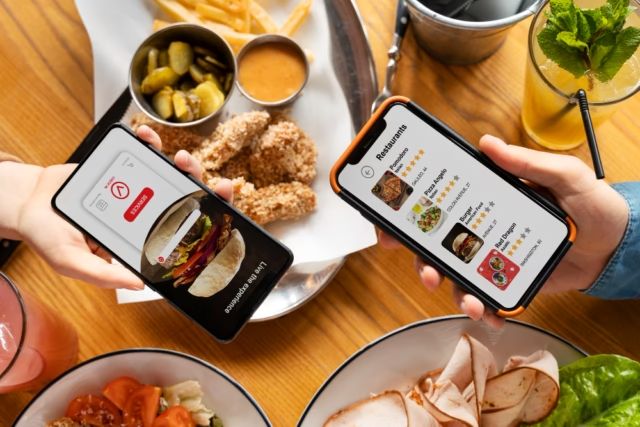Fast food has changed a lot in the last few years. Technology now plays a role in every part of fast food. Technology has made everything easier, from ordering to dining. It has made procedures that were impossible a few years ago faster and more personalised. People who eat fast food nowadays want it to be quick, quality, and easy. To always satisfy these expectations, technology is highly important. As technology and food come together, fast food is all about making eating out easy, quick, and fun.
Redefining the Ordering Process Through Digital Platforms
One of the major developments in fast food is automated ordering and smartphone applications. Brand apps let customers see menus, alter items, schedule pick-ups, and pay via their phones. These apps reduce wait times, errors, and inconvenience for contactless and pre-scheduled customers. Digital ordering systems save time and let restaurants learn what customers enjoy, how often they order, and what menu items are popular. You may use this data to improve your marketing, suggest meals for each consumer, and offer loyalty rewards to promote repeat business. Global companies like McDonald’s and Domino’s have employed smartphone apps to boost sales and tailor ordering. Enjoy your favorite meals quickly and conveniently with Takeaway Stockport.
Self-Service Kiosks and the Automation of Routine Tasks
Other fast food technology innovations include kiosks. These touchscreen interfaces let customers order, view nutritional information, and adjust meals. By reducing counter staff, kiosks help restaurants handle busy periods. Kitchen automation is also available. Robofryers, burger flippers, and drink dispensers provide consistent quality and speed. This combination of human and machine control reduces errors and speeds up procedures. Automation helps workers focus on food quality and customer care, which improves service and customer satisfaction.
The Delivery Revolution and On-Demand Dining
Delivery has made quick food available anywhere. Uber Eats, Deliveroo, DoorDash, and in-house delivery apps let customers order meals at their convenience. Customer expectations have increased due to real-time monitoring, estimated arrival times, and contactless delivery. Fast, open, and reliable are crucial now. Restaurants can serve more customers without expanding. Delivery platform data aids marketing, menu changes, and company efficiency. To improve efficiency, this transition has spurred logistical innovations including improved delivery routes and automated dispatching.
Contactless Payments and Integrated Loyalty Programs
Contactless payments and digital wallets are being accepted by more fast food restaurants, speeding up and securing transactions. QR code, mobile wallet, and tap-to-pay reduce cash handling and wait times. When integrated with loyalty programs, these payment systems track consumer purchases, reward return visits, and stimulate special offers. This seamless connection between payments and rewards increases consumer experience, brand loyalty, and provides enterprises with transactional data for planning and analysis.
Interactive Experiences and Immersive Technology
Augmented reality (AR) and gamified menus are being used by several fast food companies to keep customers entertained. Because AR menus and digital games blend food and entertainment, younger people like them. Immersive excursions help consumers post on social media and become more loyal to your brand. Businesses may market beyond interaction using interactive technologies. It allows them to creatively promote discounts and engage with customers beyond advertising.
Leveraging AI and Data Analytics for Personalization
Fast food is increasingly defined by AI and data analytics. Businesses may enhance marketing and operations by using AI algorithms to analyse client behaviour, what they buy, and when they buy it. Now businesses can predict menu items’ popularity at different times of day, schedule manpower, and maximise inventory to save waste. Chatbots and virtual assistants allow customers to purchase online, answer common questions, and offer suggestions based on past orders. This customisation exceeds suggestions. It boosts interaction, upsells, and makes clients feel individualised, which boosts loyalty.
Sustainability Through Technology
Environmental concerns are growing, and technology is crucial to maintaining a sustainable fast food firm. Predictive analytics reduces restaurant overproduction and food waste, while digital menus reduce paper waste. Intelligent kitchens and energy-efficient appliances measure energy consumption to reduce carbon emissions. Technology also enables waste-reducing packaging and digital ordering. Technology that improves sustainability satisfies consumer expectations, streamlines processes, and controls costs.
Conclusion
Technology has transformed the way we order, prepare, deliver, and eat fast food. Customers are happy when things operate more easily and consistently with new methods of doing things. For instance, smart kitchens, jobs that can be done automatically, AI-powered personalization, and payments that don’t need to be touched. Customers can utilize the service more easily, restaurants can run more sustainably, and they can adapt rapidly to changing consumer requirements. All of these things contribute to greater service and quality. As technology becomes better, fast food will be more adaptable, data-driven, and interactive. It will combine speed, ease of use, and customization in ways that were formerly considered to be inconceivable.
Visit Smartskill97 for more informative blogs.







